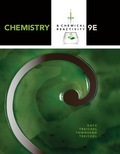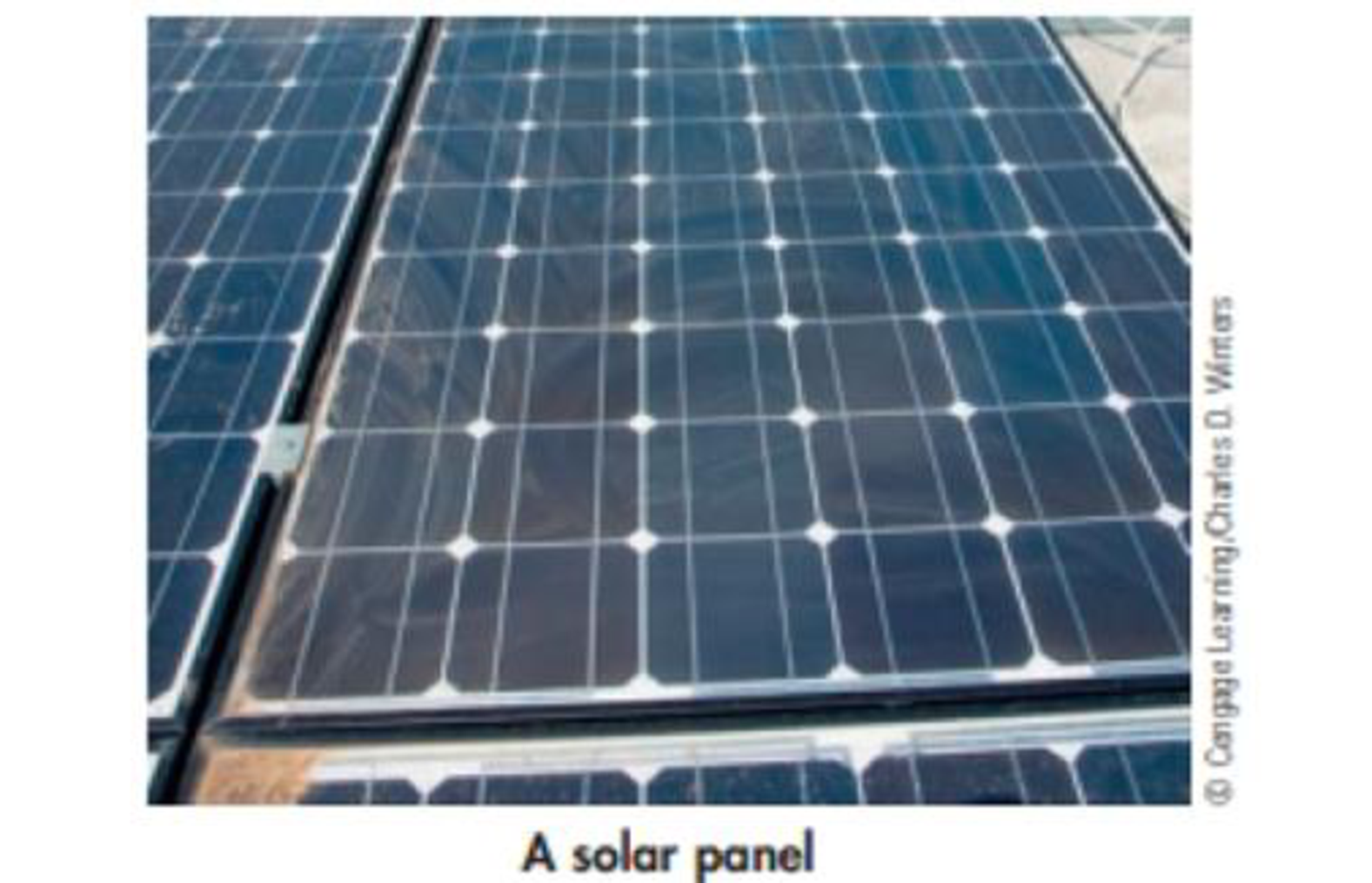
Chemistry & Chemical Reactivity
9th Edition
ISBN: 9781305176461
Author: Kotz
Publisher: Cengage
expand_more
expand_more
format_list_bulleted
Concept explainers
Textbook Question
Chapter 1, Problem 12PS
A solar panel is pictured in the photo. When light shines on the panel, it generates an

Expert Solution & Answer
Trending nowThis is a popular solution!

Students have asked these similar questions
In three dimensions, explain the concept of the velocity distribution function of particles within the kinetic theory of gases.
In the kinetic theory of gases, explain the concept of the velocity distribution function of particles in space.
In the kinetic theory of gases, explain the concept of the velocity distribution function of particles.
Chapter 1 Solutions
Chemistry & Chemical Reactivity
Ch. 1.3 - Which of the following is a pure substance? (a)...Ch. 1.3 - Which of the following is not characteristic of a...Ch. 1.4 - Prob. 1RCCh. 1.4 - Prob. 2RCCh. 1.5 - Prob. 1RCCh. 1.5 - 2. Which of the following is NOT a...Ch. 1.6 - Which of the following is NOT a physical property?...Ch. 1.6 - 2. A piece of a polypropylene rope (used for water...Ch. 1.6 - Which of the following is an extensive property of...Ch. 1.7 - When camping in the mountains, you boil a pot of...
Ch. 1.8 - Much has been written about CO2.What is its name?Ch. 1.8 - Prob. 2QCh. 1.8 - Prob. 3QCh. 1.8 - The spines of the sea urchin, corals, and...Ch. 1.8 - Which of the following has the highest thermal...Ch. 1.8 - Prob. 2RCCh. 1 - Give the name of each of the following elements:...Ch. 1 - Give the name of each of the following elements:...Ch. 1 - Give the symbol for each of the following...Ch. 1 - Give the symbol for each of the following...Ch. 1 - In each of the following pairs, decide which is an...Ch. 1 - In each of the following pairs, decide which is an...Ch. 1 - In each case, decide if the underlined property is...Ch. 1 - In each case, decide if the change is a chemical...Ch. 1 - Which part of the description of a compound or...Ch. 1 - Which part of the description of a compound or...Ch. 1 - The flashlight in the photo does not use...Ch. 1 - A solar panel is pictured in the photo. When light...Ch. 1 - Determine which of the following represent...Ch. 1 - Prob. 14PSCh. 1 - Prob. 15GQCh. 1 - Iron pyrite (fool's gold, page 11) has a shiny...Ch. 1 - Which observations below describe chemical...Ch. 1 - Which observations below describe chemical...Ch. 1 - The mineral fluorite contains the elements calcium...Ch. 1 - Azurite, a blue, crystalline mineral, is composed...Ch. 1 - You have a solution of NaCI dissolved in water....Ch. 1 - Small chips of iron are mixed with sand (see...Ch. 1 - Identify the following as either physical changes...Ch. 1 - Identify the following as either physical changes...Ch. 1 - In Figure 1.2 you see a piece of salt and a...Ch. 1 - In Figure 1.5 you see macroscopic and particulate...Ch. 1 - Prob. 27GQCh. 1 - The following photo shows copper balls, immersed...Ch. 1 - Categorize each of the following as an element, a...Ch. 1 - Categorize each of the following as an element, a...Ch. 1 - Make a drawing, based on the kinetic-molecular...Ch. 1 - Make a drawing, based on the kinetic-molecular...Ch. 1 - Hexane (C6H14, density = 0.766 g/cm3),...Ch. 1 - You have a sample of a white crystalline substance...Ch. 1 - You can figure out whether a solid floats or sinks...Ch. 1 - You are given a sample of a silvery metal. What...Ch. 1 - Milk in a glass bottle was placed in the freezing...Ch. 1 - Describe an experimental method that can be used...Ch. 1 - Diabetes can alter the density of urine, so urine...Ch. 1 - Prob. 40GQCh. 1 - The following photo shows the element potassium...Ch. 1 - Prob. 42GQCh. 1 - Four balloons are each filled with a different...Ch. 1 - Prob. 44GQCh. 1 - The photo below shows elemental iodine dissolving...Ch. 1 - A few years ago a young chemist in Vienna,...
Additional Science Textbook Solutions
Find more solutions based on key concepts
Define histology.
Fundamentals of Anatomy & Physiology (11th Edition)
Give the IUPAC name for each compound.
Organic Chemistry
An electric motor has an effective resistance of 32.0 and an inductive reactance of 45.0 when working under l...
Fundamentals of Physics Extended
2. Why is it that the range of resting blood pressures of humans is best represented by a bell-shaped curve co...
Human Biology: Concepts and Current Issues (8th Edition)
45. Calculate the mass of nitrogen dissolved at room temperature in an 80.0-L home aquarium. Assume a total pre...
Chemistry: Structure and Properties (2nd Edition)
Match the people in column A to their contribution toward the advancement of microbiology, in column B. Column ...
Microbiology: An Introduction
Knowledge Booster
Learn more about
Need a deep-dive on the concept behind this application? Look no further. Learn more about this topic, chemistry and related others by exploring similar questions and additional content below.Similar questions
- Hi!! Please provide a solution that is handwritten. this is an inorganic chemistry question please answer accordindly!! its just one question with parts JUST ONE QUESTION with its parts spread out till part (g), please answer EACH part till the end and dont just provide wordy explanations wherever asked for structures, please DRAW DRAW them on a paper and post clearly!! answer the full question with all calculations step by step EACH PART CLEARLY please thanks!! im reposting this please solve all parts and drawit not just word explanations!!arrow_forwardHi!! Please provide a solution that is handwritten. this is an inorganic chemistry question please answer accordindly!! its just one question with parts JUST ONE QUESTION, please answer EACH part PART A AND PART B!!!!! till the end and dont just provide wordy explanations wherever asked for structures, please DRAW DRAW them on a paper and post clearly!! answer the full question with all details EACH PART CLEARLY please thanks!! im reposting this please solve all parts and drawit not just word explanations!!arrow_forwardHi!! Please provide a solution that is handwritten. this is an inorganic chemistry question please answer accordindly!! its just one question with parts JUST ONE QUESTION, please answer EACH part till the end and dont just provide wordy explanations wherever asked for structures, please DRAW DRAW them on a paper and post clearly!! answer the full question with all details EACH PART CLEARLY please thanks!! im reposting this please solve all parts and drawit not just word explanations!!arrow_forward
- 8b. Explain, using key intermediates, why the above two products are formed instead of the 1,2-and 1,4- products shown in the reaction below. CIarrow_forward(5pts) Provide the complete arrow pushing mechanism for the chemical transformation depicted below Use proper curved arrow notation that explicitly illustrates all bonds being broken, and all bonds formed in the transformation. Also, be sure to include all lone pairs and formal charges on all atoms involved in the flow of electrons. CH3O H I I CH3O-H H I ① Harrow_forward6. Draw the products) formed from the following reactions. (a) HIarrow_forward
- Don't used Ai solutionarrow_forwardPlease correct answer and don't used hand raitingarrow_forward1. For each of the following, predict the products of the reaction by writing a balance net ionic equation for each. If no reaction is expected, then write NO REACTION. (a) AgNO3 (aq) is mixed with Na2CO3 (aq). (b) An aqueous solution of ammonium sulfate is added to an aqueous solution of calcium chloride. (c) RbI (aq) is added to Pb(NO3)2 (aq). (d) NaCl (s) is added to AgNO3 (aq).arrow_forward
- 4. Determine the amount in grams of AgCl (s) formed when 2.580 g AgNO3(s) is added to 45.00 mL of a 0.1250 M CrCl3 (aq) (The other product is aqueous chromium (III) nitrate) 5. Determine the amount (in grams) of Cobalt (II) phosphate formed when an aqueous solution of 30.0 ml of 0.450 M Sodium Phosphate is mixed with 20.0 mL of 0.500 M aqueous solution of cobalt (II) nitrate. (The other product is aqueous sodium nitrate)arrow_forward7. Consider the following reaction that describes the dissolution of copper metal in nitric acid: Cu (s) + 4 HNO3 (aq) → Cu(NO3)2 (aq) + 2 H₂O (1) + 2 NO2 (g) How many mL of 3.50 M HNO3 (aq) are required to dissolve 20.00 g Cu?arrow_forwardPlease correct answer and don't used hand raitingarrow_forward
arrow_back_ios
SEE MORE QUESTIONS
arrow_forward_ios
Recommended textbooks for you
 Chemistry & Chemical ReactivityChemistryISBN:9781337399074Author:John C. Kotz, Paul M. Treichel, John Townsend, David TreichelPublisher:Cengage Learning
Chemistry & Chemical ReactivityChemistryISBN:9781337399074Author:John C. Kotz, Paul M. Treichel, John Townsend, David TreichelPublisher:Cengage Learning Chemistry & Chemical ReactivityChemistryISBN:9781133949640Author:John C. Kotz, Paul M. Treichel, John Townsend, David TreichelPublisher:Cengage Learning
Chemistry & Chemical ReactivityChemistryISBN:9781133949640Author:John C. Kotz, Paul M. Treichel, John Townsend, David TreichelPublisher:Cengage Learning Introductory Chemistry: An Active Learning Approa...ChemistryISBN:9781305079250Author:Mark S. Cracolice, Ed PetersPublisher:Cengage Learning
Introductory Chemistry: An Active Learning Approa...ChemistryISBN:9781305079250Author:Mark S. Cracolice, Ed PetersPublisher:Cengage Learning General Chemistry - Standalone book (MindTap Cour...ChemistryISBN:9781305580343Author:Steven D. Gammon, Ebbing, Darrell Ebbing, Steven D., Darrell; Gammon, Darrell Ebbing; Steven D. Gammon, Darrell D.; Gammon, Ebbing; Steven D. Gammon; DarrellPublisher:Cengage Learning
General Chemistry - Standalone book (MindTap Cour...ChemistryISBN:9781305580343Author:Steven D. Gammon, Ebbing, Darrell Ebbing, Steven D., Darrell; Gammon, Darrell Ebbing; Steven D. Gammon, Darrell D.; Gammon, Ebbing; Steven D. Gammon; DarrellPublisher:Cengage Learning Chemistry: The Molecular ScienceChemistryISBN:9781285199047Author:John W. Moore, Conrad L. StanitskiPublisher:Cengage LearningChemistry: Matter and ChangeChemistryISBN:9780078746376Author:Dinah Zike, Laurel Dingrando, Nicholas Hainen, Cheryl WistromPublisher:Glencoe/McGraw-Hill School Pub Co
Chemistry: The Molecular ScienceChemistryISBN:9781285199047Author:John W. Moore, Conrad L. StanitskiPublisher:Cengage LearningChemistry: Matter and ChangeChemistryISBN:9780078746376Author:Dinah Zike, Laurel Dingrando, Nicholas Hainen, Cheryl WistromPublisher:Glencoe/McGraw-Hill School Pub Co

Chemistry & Chemical Reactivity
Chemistry
ISBN:9781337399074
Author:John C. Kotz, Paul M. Treichel, John Townsend, David Treichel
Publisher:Cengage Learning

Chemistry & Chemical Reactivity
Chemistry
ISBN:9781133949640
Author:John C. Kotz, Paul M. Treichel, John Townsend, David Treichel
Publisher:Cengage Learning

Introductory Chemistry: An Active Learning Approa...
Chemistry
ISBN:9781305079250
Author:Mark S. Cracolice, Ed Peters
Publisher:Cengage Learning

General Chemistry - Standalone book (MindTap Cour...
Chemistry
ISBN:9781305580343
Author:Steven D. Gammon, Ebbing, Darrell Ebbing, Steven D., Darrell; Gammon, Darrell Ebbing; Steven D. Gammon, Darrell D.; Gammon, Ebbing; Steven D. Gammon; Darrell
Publisher:Cengage Learning

Chemistry: The Molecular Science
Chemistry
ISBN:9781285199047
Author:John W. Moore, Conrad L. Stanitski
Publisher:Cengage Learning

Chemistry: Matter and Change
Chemistry
ISBN:9780078746376
Author:Dinah Zike, Laurel Dingrando, Nicholas Hainen, Cheryl Wistrom
Publisher:Glencoe/McGraw-Hill School Pub Co
Types of Matter: Elements, Compounds and Mixtures; Author: Professor Dave Explains;https://www.youtube.com/watch?v=dggHWvFJ8Xs;License: Standard YouTube License, CC-BY